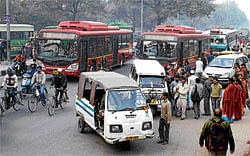No such thing as nearest Metro
The ever-expanding Metro network and a fleet of new low-floor buses have been changing the face of public transport in the Capital for the last few years.

But several areas on the outskirts of the city are still out of reach despite the presence of a vast transport network.
Daily commuting for lakhs of people remains a daunting task as several areas even in the heart of the city as well as in the periphery are miles away from Metro connectivity.
There is no such thing as the ‘nearest Metro station’ for people living in residential colonies and villages that come under certain ‘unconnected’ zones. These areas are also too congested for even buses to operate.
A major concern of commuters is the ‘last-mile connectivity’ issue — the difficulty in reaching the nearest Metro station or DTC bus stand from their homes. Data released by the Central Road Research Institute (CRRI) says the 190-km-long Phase I and Phase II of Delhi Metro cater to 35 per cent of Delhi’s total area, assuming the catchment distance of a Metro station to be a maximum of 1.5 km.
This means 65 per cent of Delhi’s total area is still unconnected by Metro. According to a survey of DTC bus routes by government’s infrastructure company RITES and Delhi’s mult-modal transport venture DIMTS, there are 567 routes, of which only 50 per cent are operational. Taking into account arterial and sub-arterial roads and assuming that each bus stop has a catchment area of 750 metres, DTC covers 75 per cent of the Capital.
Not well-connected areas
Even middle-class areas such as Dwarka, Rohini and Mayur Vihar fall under the ‘unconnected’ category. Most unauthorised colonies and slum dwellings across Delhi are also not well-connected by public transport.
Apart from those who can afford private means of transport, those living in rural areas have to depend on Gramin Seva – a scheme by the state transport department.
The idea of the scheme was to provide last-mile connectivity for people in areas where neither Metro nor buses can reach. Under the scheme, three-wheelers ply on designated routes. But despite the prescribed 166 routes, most of these eight-seater autorickshaws and some minibuses ply on main roads, causing traffic jams.
At least 6,100 such vehicles operate under the scheme, which was launched in December 2010. Commuters also complain of overcrowding and overcharging.
‘Packed beyond capacity’
“Gramin Seva operators treat passengers like animals. The vehicles are also packed beyond their capacity,” said Rajesh from Mayur Vihar Phase II, who travels on these shared autos between Mayur Vihar Phase I Metro station and Trilokpuri in east Delhi. “While a maximum of eight persons are allowed in each vehicle, I have always seen them carrying at least 14 or 15 passengers per vehicle. It’s terrifying to see people clinging on to the rear of the vehicles,” said Rajesh.
Transport department officials said there have been some deviations in the scheme but that it is still serving its purpose.
“We started the service to connect congested colonies with the Metro network. Lanes in these areas are too narrow for DTC bus operations. In that sense, the scheme is working well. The specially designed vehicles — a cross between a minibus and a three-wheeler in shape and size — are suited to operate in these areas,” said P K Gupta, Special Commissioner (Transport).
While the transport department defends the scheme, Delhi traffic police officials say Gramin Seva is a flawed idea. They say this type of service should not be run in urban areas.
“In Delhi, where traffic is already beyond the capacity of roads to accommodate, the introduction of Gramin Seva was a bad idea. This service must be restricted to rural areas,” said P K Sarkar of School of Planning and Architecture.
‘Minibuses better’
“Instead of autorickshaws, minibuses are suitable for short-distance commuting. Minibuses are safer as well and easy to regulate because unlike autorickshaws, they will have to stop only at designated stands. This will not affect traffic,” added Sarkar.
According to traffic police, a high number of Gramin Seva operators frequently violate traffic rules. Of all vehicle users, the highest number of traffic violations were reported from Gramin Seva drivers last year.
The traffic police resent the fact that the transport department did not even consult the police to decide on halting points for Gramin Seva and the number of licences to be issued on a particular route. Design flaws in transport schemes happen due to absence of a unified metropolitan transport authority. “The Capital needs a unified authority to formulate any scheme, be it framing a policy or making strategies,” Sarkar said.
Deccan Herald is on WhatsApp Channels| Join now for Breaking News & Editor's Picks